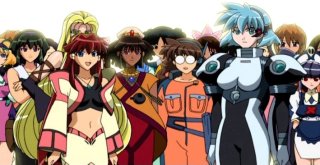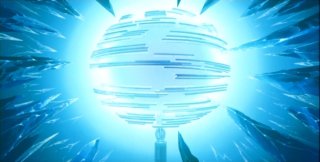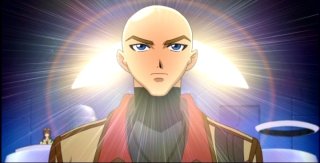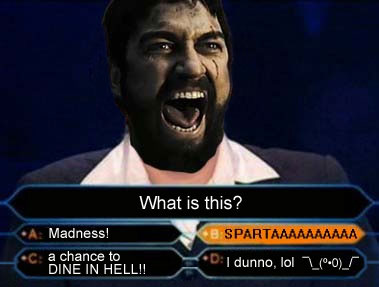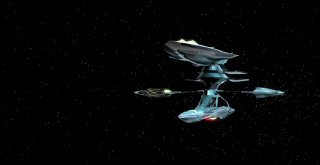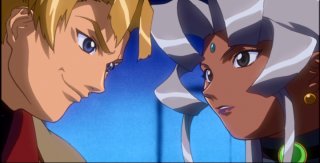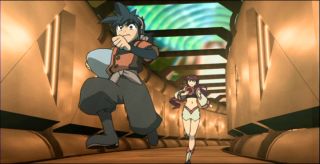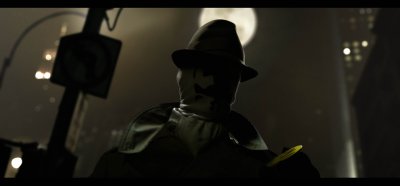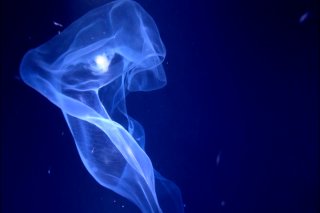Vandread: Second Stage
I finished Vandread: Second Stage last week, but I was so busy this week that I haven’t had time to post any thoughts until now. As with the first series, I found myself quite pleased with this series. It’s more or less the continuation and conclusion to the first series, so this is isn’t too surprising. Potential spoilers ahead…
The men and women aboard the pirate ship Nirvana have learned to work well together and get past their cultural differences. This is a good thing because the enemy they face seems to be quite adaptable, raising the bar during each battle. We learn a lot about the enemy in this series, but it basically boils down to this: after initial colonists left from Earth, the planet suffered some sort of meltdown and the people of Earth could no longer reproduce. The Earthlings became jaded and twisted, consumed by hate and fear, eventually constructing a robotic fleet that would go after the colonists, harvesting their organs so that the Earthlings could continue to live. (I don’t know how much of this will make sense if you haven’t seen the series, but it would take too long to go through the entire story…)
The revelations are meted out at a reasonable pace and are mixed with various character development arcs that make up the series’ emotional core. Interestingly, the single most important character in the first series turns out to be something I barely noticed in the first series: the Paksis.
The Paksis, it’s alive!
The Paksis is the power plant of the Nirvana – it’s also apparently a living, sentient being. The Paksis was discovered on Earth as the colonists were beginning to expand into the galaxy. It’s unique properties made it ideal for an energy source, and so it was split into two: one remained on earth, the other was sent out with the colonists (eventually ending up on the Nirvana). The red Paksis has suffered as the people of Earth enslaved it to construct and power their harvester fleet, while the blue Paksis went on as part of the colonists’ fleet.
The Paksis is behind a lot of the confusing things that happen in the series – it’s the driving force behind the way ships combine and evolve, and it’s also got a self-preservation instinct that opened a wormhole and sent them light-years away in the first series. During many of the battles, the enemy shows the ability to adapt and evolve, mimicking many of the powers of our heroes. This lead to lots of questions until I realized that the Earthlings were simply using their Paksis to copy the fighting machines and tactics that were created by Nirvana’s crew. Steven Den Beste wrote about this a while back, using the Japanese word kiai (which essentially means “fighting spirit”) as a starting point:
All through the series the four primary characters seem to have an unreasonably fast learning curve regarding the abilities of the various versions of Vandreads as they appear, becoming adept at using them in just a few seconds. It’s not clear that the controls really matter, in fact. When they’re sufficiently motivated, the machine does what they need it to do pretty much no matter what control they use.
And afterwards they’re all weary, though Hibiki is usually the worst off in that regard. It’s because he’s been using his ki to make the machines run — because they’re not really machines.
What’s even more interesting is the cases where a character manages to raise their ki and when they do so it directly causes changes of some kind before our eyes. In Vandread it’s all about the Paksis; what they’re doing is to somehow link to the Paksis, which uses its mysterious powers to create what is needed. It isn’t necessarily a conscious need, of course. Hibiki does this more than anyone, and Meia/Dita/Jura do it to some extent, but Bart also does it once, in episode 16. (That is, the third episode of the second series.) Bart attains a sufficiently high emotional state that he is able to reach the Paksis, and as a result the Nirvana is changed to create banks of missile launchers.
Bart didn’t do that deliberately. But in the emotional state he was in at the time he didn’t question it. He was able to fully control them immediately. They did exactly what he expected them to do and needed them to do, even to where they struck only enemies and dodged around friends.
In essence, the entire series could be seen as a struggle between the red and blue Paksis, and the way the blue Paksis draws on the power of it’s crew leads to a lot of interesting character dynamics. As with the first series, there are several interesting character arcs here. One is the aformentioned arc with Bart, who becomes attached to sick little girl and is thus able to achieve an emotional state that allows him to interface with the Paksis (in order to protect the girl). It’s a fantastic episode, and it features a great reveal at the end:
Bart’s new haircut
Hibiki continues to grow, as does his relationship with Dita, and it turns out that Hibiki plays a surprisingly important role in unifying the opposition to Earth’s harvester fleet. Oh, and speaking of surprises, there’s a big one towards the end. Some hints were dropped, but I doubt anyone saw it coming (indeed, at first, I was really confused by what happened).
All in all, the story progressed well and most of the unanswered questions were resolved. We get more background on Earth, we get more detail on why Tarak and Mejale are segregated by sex (though I’m still not totally clear on that one), and of course we find out a lot more about many of the characters. There were some nitpicks and open questions, but nothing major. For instance, what was the deal with Gascogne’s return? I was happy to see her come back and all, but a little baffled as to how she managed to do so… it seemed extraneous and unnecessary to me. Also, the battles with Earth’s forces got a little repetitive, but you’d expect that in a series where our heroes engage the enemy in every episode. However, as I noted in my review of the first series, nitpicks don’t seem to bother me with this series.
In the end, it’s a solid series, and pretty much exactly what I was looking for. By the end, I was sad to see the characters go, but pleased that there was some sort of closure to the story that made sense. Thanks again to Steven for the recommendation.
As usual, more screens and comments below the fold…
…
